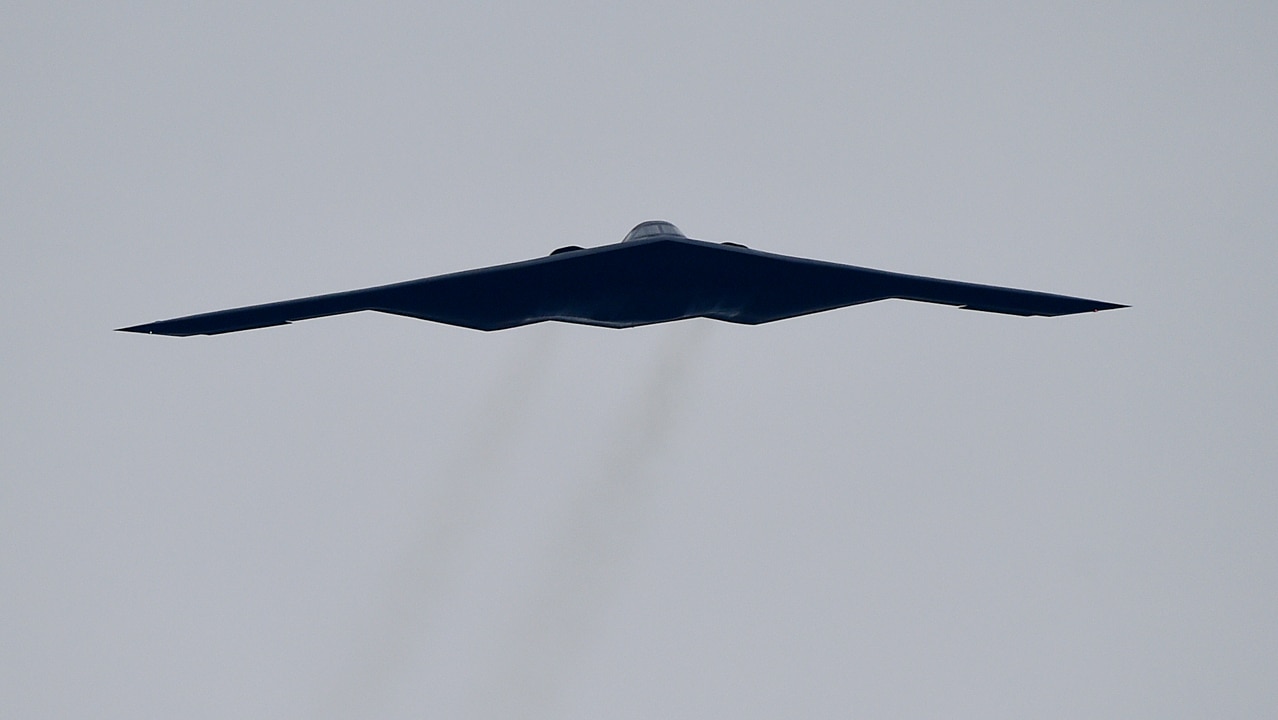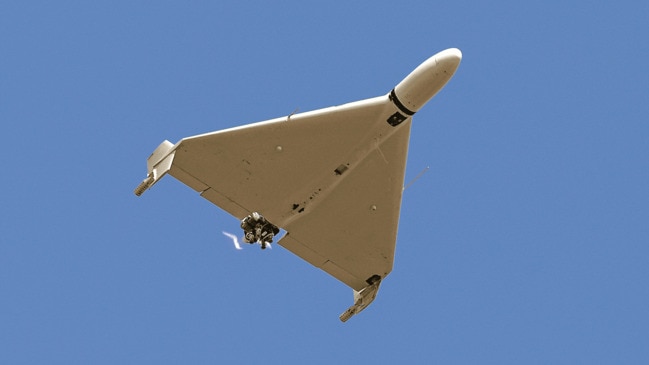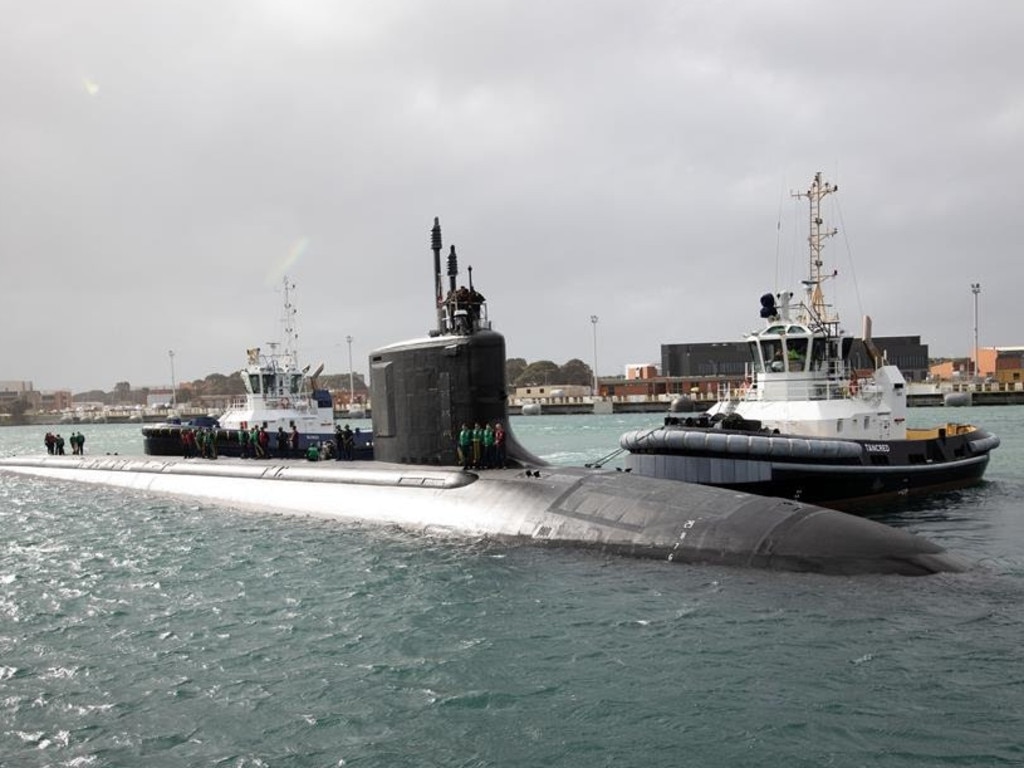I wish we could celebrate its birthday. But here’s the thing. After three full years, AUKUS has not added a single weapon or platform to the order of battle of the Australian Defence Force.
AUKUS pillar two, the idea for enhanced technical co-operation and commercial freedom between the US, Australia and Britain, though we’ve had intimate co-operation for decades, also has not produced a single product. The Biden administration has actually put some severe limits on the degree of commercial intimacy with Australia in some of the most sensitive technologies.
To top off the trifecta of AUKUS woes, there isn’t really much chance the nuclear-powered submarines will be delivered anywhere near on time, even though the time line is already measured in decades. Max Hastings in The Times quoted British defence insiders as saying there is simply no way the Brits can produce on time the British version of a nuclear submarine we’ll supposedly build in Adelaide in the 2040s, after we’ve bought three second-hand Virginia-class submarines from the US.

The AUKUS achievement so far is political. The Biden administration shows it can call allies to its side. The Brits stand to make billions of dollars selling us their as-yet undesigned sub.
The Albanese government can look busy and historic, mixing with the great powers, talking grandly of Australian security. Yet all its announcements are over such preposterously long time lines, it will never have to take responsibility for how they actually work out.
In the meantime, it doesn’t have to do much at all except pay our allies some billions of dollars. Meanwhile, it employs hundreds of bureaucrats beavering away on treaties and regulatory frameworks. It’s Yes Minister defence, without the bother of a military. It sends a few Australian submariners to the US to undertake submarine training courses. Recall we had hundreds of personnel working on the French subs. We’ve had hundreds working on many programs we’ve later cancelled.
All of that is really a sideshow. The real news in defence is that as the Albanese government’s first term is ending, Australia’s military capability has been substantially cut, seriously diminished. A left-wing pacifist government could hardly have done more to disarm Australia.
Our defence force is significantly weaker than when Labor came to office. Defence Minister Richard Marles constitutes a uniquely lethal combination. He presents quite well, he’s good at diplomacy, he talks a good game on military stuff so long as he doesn’t get taken too far from his talking points, but he delivers nothing.

The Albanese government is all tactics and no strategy. When in opposition, and in its first months in office, it talked of the great things it would do in defence; this was essentially tactical management of the politics of the moment. AUKUS is a political management tool. It deflect criticisms the government isn’t doing enough by pointing to AUKUS subs, just over the horizon. This is not a partisan criticism. Scott Morrison did the same thing.
Here’s the harsh reality. There are three things we’d like: a credible defence force; nuclear subs; and the current defence budget with its modest growth projections. The hard truth is, you can have any two but not all three. The government should choose to have both subs and a credible ADF, and ditch the grossly inadequate defence budget. Pretending you can have AUKUS subs and a formidable ADF in the current budget is utterly dishonest.
Instead, the government has chosen to go for subs, keep the inadequate defence budget and cannibalise and destroy much of the rest of the ADF. Given we might never actually get the subs, or, more likely, we’ll get some but possibly years or even decades late, this is profoundly irresponsible and dangerous.
This year, our defence budget is 2 per cent of GDP. Mike Pezzullo, a former deputy secretary of the Defence Department, told Inquirer: “I’d say there’s a gap of 10 years, arguably out to 20 years. Conservatively, we’ve written off, for heavy capability, the next 10 years. A self-reliant defence force looks like a defence budget of 3 per cent of GDP.”
Retired general Peter Leahy, former head of army, angered the government by pointing out the undeniable truth that the ADF is weaker now than when Labor came to office. He confirmed to me that’s still his view and cites all manner of missing capabilities. Like every defence professional, he’s astounded at the ADF’s lack of drone capability.
Leahy tells Inquirer: “It’s just unfathomable the way they think we (the army) could go and do anything now the way drones are. The Ukrainians have sunk a chunk of Russia’s Black Sea fleet with drones. But I’m more concerned with anti-personnel and anti-armour drones. We’ve got no defence against them. There are anti-drone capabilities but Defence doesn’t seem much interested.”

Defence has been a shocking mess since John Howard retired. But the Albanese government is proving one of the worst governments because it is cruelling existing and proximate capabilities while proclaiming we face the gravest strategic circumstances since World War II.
The Albanese government deserves credit for one thing. It has enticed the Americans into implementing their force dispersal strategy, designed to make their forces harder for Beijing to hit, by putting more US defence assets for longer periods in northern Australia. Soon, a couple of US nuclear subs will start rotating through Perth for months at a time. This enhances Australian security.
However, it’s also part of the crippling psychology of total dependence, and national irresponsibility, that Australian governments have long practised in defence. We are completely dependent on the US militarily, diplomatically and politically. If the Americans ever get tired of defending us we have no capability to defend ourselves. As both Ukraine and Israel show, nations that can defend themselves to some significant extent are much likelier to get allied help in a crunch. We have no idea how US politics will develop. Having a credible ADF is the best way to encourage the Americans to stick with us, and it would give us options whatever strategic circumstances come.

A commitment to a tiny fleet of nuclear-powered submarines that may come to fruition in the 2050s is no substitute. I don’t want to be misunderstood. I support AUKUS and support getting nuclear-powered submarines, but it’s insane to do that at the total expense of the rest of the ADF.
The Albanese government has made five big mistakes, five crucial blunders, that cripple defence.
Big Mistake No.1 is never confronting or honestly explaining the severe defence budget circumstances. Marcus Hellyer, now with Strategic Analysis Australia, has analysed defence spending for decades and knows the defence budget intimately. In a recent note for his colleagues, he wrote: “The bad news is (the) defence funding plan hasn’t changed since the 2016 White Paper, despite all the talk about the worst strategic circumstances since WWII. The Defence Strategic Update 2020 essentially is a straight line continuation of the 2016 line. The current funding line doesn’t start to grow above that until 2027/28.”
Hellyer demonstrates that funding this year is, in dollar terms, just what was predicted in 2016. That’s a much smaller percentage of GDP than was predicted. So the dollar amount has been delivered but we haven’t come near the promised percentage of GDP. That’s because nominal GDP grew unexpectedly as a result of inflation. So the same dollar amount is a real decrease in spending power.

Defence spending is not compensated for inflation above the forecast rate. Hellyer’s note continues: “So no real change in funding for over a decade since the Defence White Paper in 2016 – that’s despite what is probably an 8 to 10 per cent hit to buying power due to inflation, $8bn transferred within the portfolio to the Australian Signals Directorate, higher financial incentives for recruitment and retention etc.”
Marles sometimes says the government has injected an extra $50bn into defence over the next decade. But that doesn’t begin to show meaningful increase until the first year of the third term of an Albanese government.
The government has done nothing more than make a funding promise on behalf of a future government two parliaments away. Defence is always a conspiracy of confusion and concealment, but the government’s ridiculous budgetary smoke and mirrors does our nation a grave disservice. We are choosing near-term partial disarmament because we won’t spend the money, while promising ourselves long-term defence nirvana on Star Trek timelines.
Big Mistake No.2 is to sacrifice the ADF of today, and of the next five to 10 years. This is partly to pay for AUKUS and partly because Defence was already radically under funded. The carnage in defence is prodigious. More service people have left the ADF than joined under Anthony Albanese. The ADF is 5000 people short of target.
The list of capabilities cut back, abolished, diminished or infinitely deferred is frightening. When the government commissioned the Defence Strategic Review (anyone remember that once historic but much censored, bowdlerised and finally ignored strategic orphan?) there was much briefing that it would result in not only new platforms but new and modernised weapons on existing platforms. In an interview he was gracious enough to grant me, the Prime Minister referenced missile defence as one area of neglect his government would fix.

So, leaving its grandiloquent Gilbert and Sullivan Duke of Plaza Toro words to one side, what has the government actually done to the ADF?
We have a pitifully small, elderly and undergunned surface fleet – eight ageing Anzac-class frigates, three air warfare destroyers. Canberra abandoned plans to modernise the Anzac-class frigates, instead retiring one altogether (so we’re down to seven). There are rumours another may go as, say sources, we only have crews to man five anyway. The government had planned to put Tomahawk missiles on the Collins-class submarines, giving them more reach and punch. That was abandoned too.
The government cancelled long-established plans for a fourth squadron of F-35 multi-role fighters. The air force is the most competent, hi-tech and uncontroversial of the services because it just buys its planes from the US and these are automatically upgraded as Washington upgrades its planes.
We now have approximately 100 fast jets, including Growlers and Super Hornets. A government seized of the strategic dangers posed by China would have bought the fourth squadron of F-35s and expanded the air force by one squadron. Not a chance. No new planes for the air force. The government also has abandoned plans for ballistic-missile defence, despite what Albanese said to me, and for medium-range air defence systems. Two replenishment and logistic ships have been abandoned, though you can’t have “impactful projection” (the clumsiest neologism in Australia’s history, surely?) if you can’t support ships off shore. We’ve abolished planned new de-mining ships.
We’ve cut the number of army armoured vehicles from 450 to 129 (I supported that, foolishly thinking money saved would be invested in other weapons). We’ve retired our old tanks while our new tanks are yet to arrive (I know, I don’t rate tanks, but that’s another capability gap). We’ve grounded army’s lift helicopters and their replacements are a long way off.

There are plenty of other things we’ve abolished or postponed. This is a program to shrink the ADF, not to answer uniquely dangerous times. It’s true the government plans general purpose frigates. These will be “tier two” vessels and their design, manufacturer and much else have not yet been chosen. Cue endless delays.
Which leads us to Big Mistake No.3, ignoring the combat lessons of the Ukraine war. There is no policy area in which the Albanese government has acted with more inexplicable irrationality than drones. Everyone in the world, except for the Labor government, understands drones are now an essential part of warfare. They’re not everything. They’re not always decisive. But they’re essential. The Ukrainians can sink capital Russian ships. The Houthis can fight the mighty US Navy to a standstill in the Red Sea. All because of drones’ asymmetric power.

In the Red Sea the Houthis attack a US ship with drones worth less than $10,000. The US destroys the drones with missiles costing $1m each, or several million dollars.
Canberra’s dysfunctional defence culture is to spend decades acquiring, and endlessly tinkering with, exquisitely expensive, complex platforms that we buy in tiny numbers and that can be deployed only as part of a US taskforce with US protection. It’s nuts. Finally, embarrassed and annoyed by public criticism, the army plans to acquire a very small number of US Switchblade armed drones. Their range is about 10km. That’s part of our doctrine of keeping the enemy at risk far from our shores?
For a time, the government tried to deflect drone discussions by referring to the Ghost Bat. This was meant to be the first Australian-designed combat aircraft, unmanned and autonomous, in 50 years. For years governments said, don’t you worry about drones, we’ve got the Ghost Bat! Now it turns out the Ghost Bat won’t be armed, it’s just another of our endless surveillance aircraft.
Everyone, except Canberra, understands successful drone warfare involves swarms of cheap, expendable and preferably different drones that overwhelm even sophisticated defences. Australian companies make such drones and sell them to Ukraine and the US. Would the ADF buy any? Not a chance.
Which brings us to Big Mistake No.4. The fantastical future the Albanese government imagines, and for which we are destroying so much in defence, is unlikely to come about as planned. The British nuclear submarine program is miles behind schedule, facing intense budget pressure. The chance it can produce a credible design for us in reasonable time is slight.
And because we’ve scheduled so much capability to start in 10 years the amount of work we’re notionally going to undertake simultaneously is, literally, unbelievable. And it’s bound to cost much more.

I’m not against ambition. But we’re destroying present capability, and necessary capability in the dangerous five to 10 years ahead, for a dream unlikely to come true.
This is related to Big Mistake No.5, the failure to determine and communicate a coherent strategic rationale. Everybody knows the nuclear subs are a response to China. The government won’t say so. The subs would be formidable, but they’re not a defence force all by themselves. What are they actually supposed to do? Marles sometimes says they’ll protect sea lines of trade. This is preposterous. Subs are designed to sink surface ships. They can destroy sea lines, not protect them. If they’re for general deterrence we need to explain how they’ll relate to the rest of the ADF. But as the government is tearing up much of the ADF, that’s a difficult question.
AUKUS has been a partial political success. Operationally, it has added up to nothing. Meanwhile the Albanese government is eroding our actual defence capabilities. It’s surely the strangest path taken by any nation that believes it faces the most dangerous strategic circumstances in 80 years.
Nonetheless, happy birthday, AUKUS – but even you cannot make up for this government’s five incalculable strategic blunders.






Later this month, on September 16, the AUKUS agreement, under which Australia plans to acquire eight nuclear-powered, conventionally armed submarines, turns three.